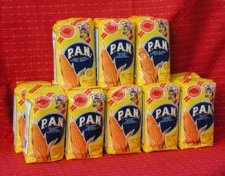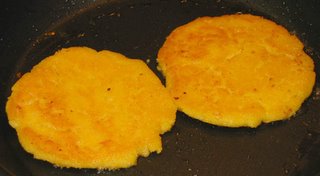Last night I had a group of friends over ..... mostly Spanish teachers (we teachers need to party!!) and some other friends, from the US, Venezuela, Puerto Rico, Colombia, Ecuador, Cuba, Italy, Canada (French), Belgium ... and probably a few more places I'm not remembering. I love bringing people together to celebrate all of our stories.
My two Venezuelan friends, Liz Sandra and Gilde, brought the ingredients to make arepas, a truly delicious side dish typical of Venezuela. Made with a base of corn meal, they can be rounded and white (al estilo caraqueño), or flatter and yellow, colored with achiote (al estilo maracucho)

Arepas
Little did I know we were in for a chapter of the long-running but light-hearted feud between the caraqueños and the maracuchos! Gilde is from Caracas, and Liz is from Maracaibo.
Liz and Gilde both showed up with the main ingredient, a cornmeal flour called Harina Pan...

Harina Pan
...and their Tosty Arepas:

Tosty Arepas
La maracucha, Liz was also packing her achiote seeds to add color y sabor. The seeds are heated in oil until they release their color, then the oil is drained and added to the masa.
To make the masa for the arepas, you mix the Harina Pan with water and salt. Liz explained that there are heated discussions about the best way to do this – in some places you put the flour down first and then add the water; in others, you start with a bowl of water and add the Harina Pan into that. You mix and mix until you have a smooth masa.
La caraqueña, Gilde, kept her masa blanca, while Liz added the achiote-colored oil to give her masa a rich yellow glow.
Then to the preparation – two different cities, two different ways. Both started by breaking off a large chunk of masa and rolling it into a ball. But that's where the similarity ended. Liz flattened out each ball of dough and placed it on a hot iron griddle (my Mexican comal that I bought after my trip to Oaxaca). She toasted the disks on the griddle until they were browned, and then put them in the oven to finish cooking. The true test of whether she did it right? If they puffed up while in the oven. They did!! And they were delicious. (And by the way, she never used her Tosty Arepas!)

Arepas maracuchas
Gilde took her balls of dough and put them directly onto the Tosty Arepas. This is the coolest appliance! (I think it's going to be on my Christmas list ...) To add some more flavor, she took the pan drippings from the roast pork that had just come out of the oven and greased the Tosty Arepas with that. Close the lid of the Tosty Arepas, click it, let it cook through one cycle for soft arepas or two cycles for ones with a crispier outside, and they're done!

Arepas caraqueñas
There was no contest – there were two clear winners, both la arepa caraqueña and la arepa maracucha. Both were absolutely delicious, and were finished up so quickly that a second round of masa had to be made.
Now, the next morning, I'm wishing I had some for breakfast ..... they are often eaten for breakfast in Venezuela, and I can see why; I would eat them at every meal! .... Hmm, there's still some Harina Pan downstairs ...


2 comments:
I'm of Colombian descent, and arepas are a staple there too. My family is from Barranquilla on the coast, and they make arepa de huevo, which is made with white harina and then an egg is placed inside the arepa which is then cooked in a skillet. You bite into the warm arepa and the surprise is a perfectly fried egg inside. It is delicious. We also eat the plain white ones with coffee or on the side with eggs at breakfast, or add grated cheese to the harina and make arepas de queso. The yellow arepas con queso (where the arepa is split and the cheese melted inside and served like a sandwich is from Bogota, I believe (you can buy those at all the street fairs in nyc). Que antojos!
vlake6@yahoo.com
And...has anyone tried the "sweet" arepas??? In my house, when my mother visits from Venezuela, she makes up to a dozen of those and my adult-kids go crazy for them, leave alon my husband! Sweets arepas are prepared putting sugar (a pinch of salt first) to the "masa" and then are fried on a small-deep "paila" half-full of oil, where the arepa "se infla" and get a tan color. You can try them with ham and cheese or just alone! mmmm....delicious.
Post a Comment